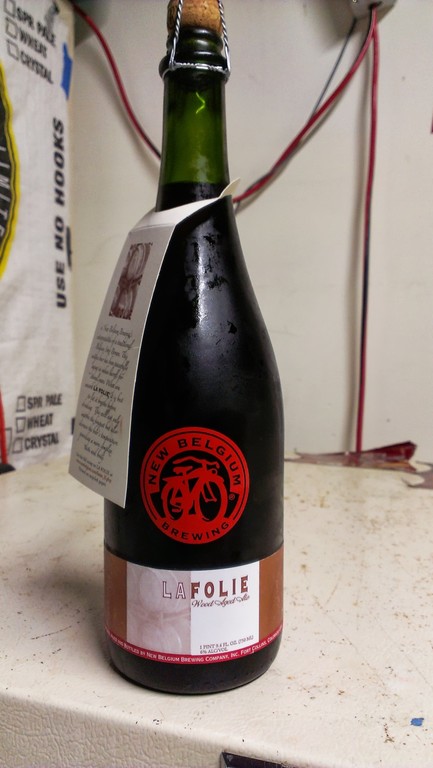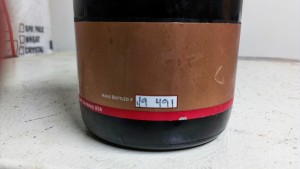This past Friday, I brewed the next beer in the sour pipeline. I’ve been alternating back to a Flanders Red this time, and one of my all-time favorite beers and sours. New Belgium‘s La Folie.
I fell in love with La Folie in 2008 and in early 2009 the Texas market was flush with the newly introduced Lips of Faith series along with hand-bottled batches of La Folie. I scavenged the Austin market and obtain nearly 2 cases of this amazing beer and I still have 4 or 5 of these sours aging.
This brewnight was also the 6 month date from the first sour beer I brewed with the Roeselares yeast with some help from some of my favorite local sour beers from Jester King and it was time to make room in the sour pipeline.
As I brewed the La Folie recipe found in an older BYO article, I transferred the original Flanders Red, in Rubicundiusque or Ruby as it’s now called, into a keg for serving. The beer had matured wonderfully. In the last month it had been resting on a couple ounces of Pinot Noir oak cubes providing some wine-barrel like flavors and aromas.
All of these great aromatics and tastes were present in the samples. The sour aspect wasn’t nearly as potent as La Folie, but Ruby is definitively sour and strikes a great balance on the pallete for an unblended sour.
After moving Ruby out of the carboy with oak cubes it was time to transfer in the second sour in the pipe line: 5 gallons of Fancy Lad. Early sampling of this beer showed great things happening but the lighter gravity left the mouthfeel a bit thin. I decided that I would bolster this with some malto-dextrin. I settled on 4 ounces in the 5 gallons. I mixed the malto-dextrin with 16 oz of water and boiled for 5 minutes before adding it to the bottom of the carboy to help mix it in when racking from the source carboy into the target.
Once the brew session was complete, the La Folie wort went into a carboy with the Roeselares/Jester King dregs yeast cake.
After primary fermentation is complete in a few weeks I plan to enjoy a very aged and tasty 2009 La Folie and pour the dregs of this great beer into my La Folie. I can only hope this will impart at least some of La Folie’s greatness into my beer.
Here’s the recipe
Recipe Details
| Batch Size | Boil Time | IBU | SRM | Est. OG | Est. FG | ABV |
|---|---|---|---|---|---|---|
| 5 gal | 60 min | 20.3 IBUs | 11.8 SRM | 1.062 | 1.014 | 6.3 % |
| Actuals | 1.046 | 1.01 | 4.7 % | |||
Style Details
| Name | Cat. | OG Range | FG Range | IBU | SRM | Carb | ABV |
|---|---|---|---|---|---|---|---|
| Flanders Red Ale | 17 B | 1.048 - 1.057 | 1.002 - 1.012 | 10 - 25 | 10 - 16 | 2.2 - 2.7 | 4.6 - 6.5 % |
Fermentables
| Name | Amount | % |
|---|---|---|
| Brewer's Malt, 2-Row, Premium (Great Western) | 9.75 lbs | 75.03 |
| Crystal, Medium (Simpsons) | 1.31 lbs | 10.08 |
| Munich Malt | 1.31 lbs | 10.08 |
| Wheat, Flaked | 10 oz | 4.81 |
Hops
| Name | Amount | Time | Use | Form | Alpha % |
|---|---|---|---|---|---|
| Liberty | 1.06 oz | 60 min | Boil | Pellet | 3.9 |
Miscs
| Name | Amount | Time | Use | Type |
|---|---|---|---|---|
| Calcium Chloride | 5.00 g | 60 min | Mash | Water Agent |
| Gypsum (Calcium Sulfate) | 2.70 g | 60 min | Mash | Water Agent |
| Epsom Salt (MgSO4) | 0.50 g | 60 min | Mash | Water Agent |
| Whirlfloc Tablet | 1.00 Items | 15 min | Boil | Fining |
| Yeast Nutrient | 1.00 tsp | 5 min | Boil | Other |
Yeast
| Name | Lab | Attenuation | Temperature |
|---|---|---|---|
| American Ale (1056) | Wyeast Labs | 75% | 60°F - 72°F |
| Belgian Lambic Blend (3278) | Wyeast Labs | 70% | 63°F - 75°F |
Mash
| Step | Temperature | Time |
|---|---|---|
| Saccharification | 152°F | 75 min |
| Mash Out | 168°F | 10 min |
Notes
| Mash at 154 °F (68 °C). Boil for 60 minutes. Ferment with neutral ale yeast at 75 °F (24 °C), then rack to barrel and add sour blend. Aging time is totally up to the barrel. This is where years of tasting and blending come in handy. If you want to blend, try ~ 20% of a sweeter (younger) barrel, ~30% of a nice mild sour barrel and ~50% of a well established “tour gripper” with nice oak notes (cherries, horse blanket, etc). (Young usually means ~ 1 year, mid range ~2 years and grippers are 3+ years.) But there are no rules here. Do whatever works for you. Don’t have the budget (or room) for a barrel? Try this “poor man’s” method of emulating some of the aspects of barrel aging. Conduct your primary fermentation in a bucket or ferment the beer with ale yeast, then rack it to a bucket — adding any “bugs” that may be called for. Buckets are more permeable to oxygen than barrels are, so let the beer condition in the bucket for only about 3 months, then rack it to a carboy for the remaining conditioning time. Two weeks before racking, take 3.0 oz. (85 g) of oak cubes (French oak, medium toast) and soak them in wine. Use Chardonnay for the Temptation clone, Pinot Noir for La Roja, Cabernet Sauvignon for Darth Porter and Burgundy or Meritage for Grand Cru and La Folie. Change wine every 3 days to lessen the intensity of the new oak. Add cubes when beer is racked to carboy. |
Download
| Download this recipe's BeerXML file |



Pingback: This and That